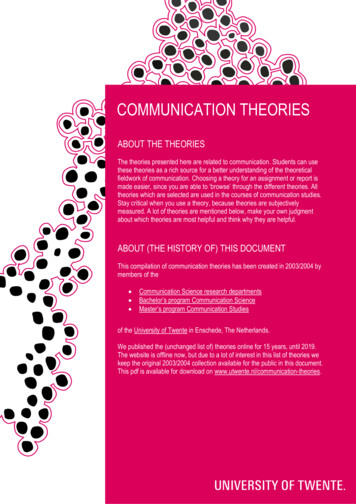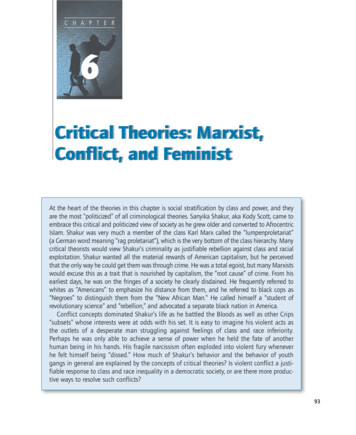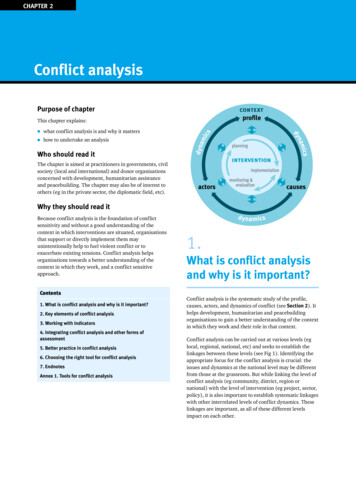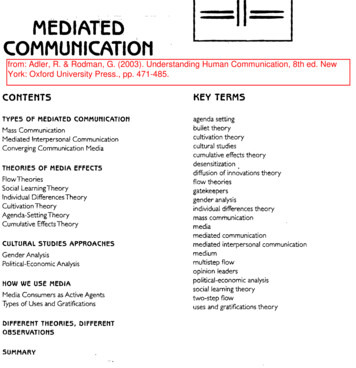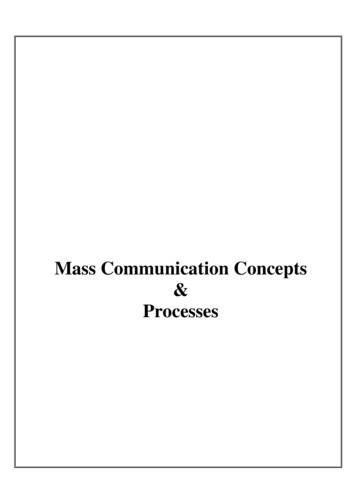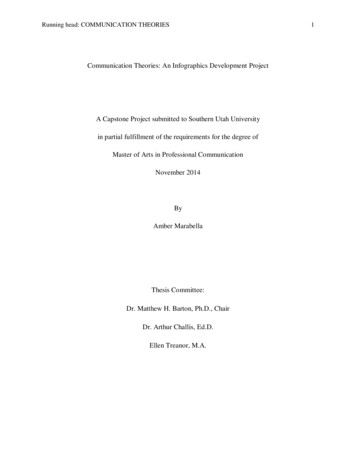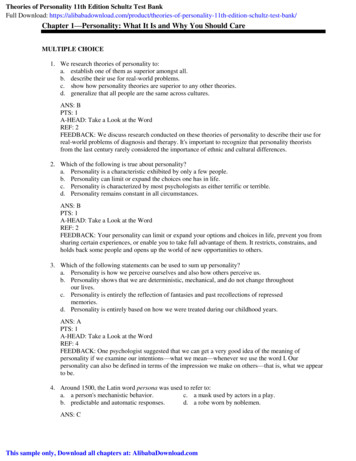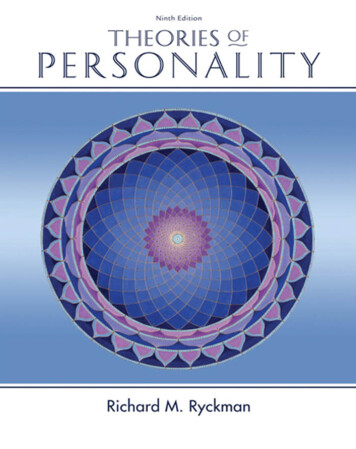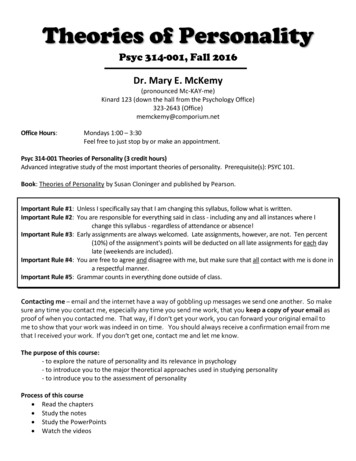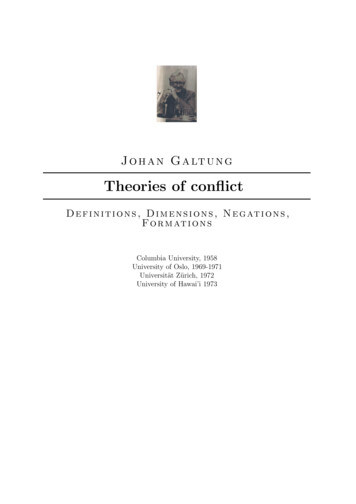
Transcription
J o h a n G a lt u n gTheories of conflictD e f i n i t i o n s , D i m e n s i o n s , N e g at i o n s ,Fo r m at i o n sColumbia University, 1958University of Oslo, 1969-1971Universität Zürich, 1972University of Hawai’i 1973
ContentsPreface51 DEFINITIONS OF CONFLICT1.1 Contradiction and Incompatibility: A First Approach . . . . .1.2 Contradiction and Incompatibility: A More Formal Approach1.3 The Goal Dimension: Drives vs Consumption . . . . . . . . .1.4 Conflict: Actors in Pursuit of Incompatible Goals . . . . . . .1.5 Two Types of Conflict: Structure-Conflict and Actor-Conflict1.6 Frustration and Conflict . . . . . . . . . . . . . . . . . . . . .1.7 The Elements of Conflict . . . . . . . . . . . . . . . . . . . . .1.8 The Phases of Conflict . . . . . . . . . . . . . . . . . . . . . .1.9 Conflict Theory and Game Theory . . . . . . . . . . . . . . .2 DIMENSIONS OF CONFLICTIntroduction . . . . . . . . . . . . . .ACTORS . . . . . . . . . . . . . . .2.1 Domain . . . . . . . . . . . . .2.2 Structure of Actors . . . . . . .2.3 Consciousness . . . . . . . . . .GOALS . . . . . . . . . . . . . . . .2.4 Scope . . . . . . . . . . . . . .2.5 Structure of Goals . . . . . . .2.6 Acceptability . . . . . . . . . .INCOMPATIBILITY . . . . . . . . .2.7 Analyticity . . . . . . . . . . .2.8 Substitutability . . . . . . . . .2.9 Incompatibility . . . . . . . . .PURSUIT . . . . . . . . . . . . . . .2.10 Attitude . . . . . . . . . . . . .2.11 Behavior . . . . . . . . . . . . .2.12 Resource . . . . . . . . . . . . .THE ABC TRIANGLE . . . . . . 9597101105
3 NEGATIONS OF CONFLICT3.1 Transcendence . . . . . . . . .3.2 Compromise . . . . . . . . . . .3.3 Deepening . . . . . . . . . . . .3.4 Broadening . . . . . . . . . . .3.5 Fission . . . . . . . . . . . . . .3.6 Fusion . . . . . . . . . . . . . .3.7 Intra-Action . . . . . . . . . . .3.8 Inter-Action . . . . . . . . . . .3.9 Conflict-Addition . . . . . . . .3.10 Actor-Addition . . . . . . . .3.11 Penetration . . . . . . . . . .3.12 Incapacitation . . . . . . . . .1071101101121121141141151151161161171174 FORMATIONS OF CONFLICT4.1 Introduction . . . . . . . . . . . . . . . . . .4.2 The Key Conflict Formations: A Brief Guide4.3 Center vs Periphery Formations . . . . . . .(1) Capitalist Imperialism . . . . . . . . . .(2) Social Imperialism . . . . . . . . . . . .(3) Superpowers vs the Rest . . . . . . . . .(4) Big Powers vs the Rest . . . . . . . . . .(5) North vs South . . . . . . . . . . . . . .4.4 Center vs Center Formations . . . . . . . . .(6) Capitalist vs Socialist . . . . . . . . . . .(7) Capitalist vs Capitalist . . . . . . . . . .(8) Socialist vs Socialist . . . . . . . . . . .125125126129130132137142145149150154154.Epilogue: Basic humand needs, conflict and peace reasearch159Appendix: A Framework for the Analysis of Social Conflict167
PrefaceTheories of Conflict is based on lectures given when the author was professor of sociologyat Columbia University 1958-60, of conflict and peace studies at the University of Oslo1969-1977, and visiting professor at Universität Zürich spring 1972 and University ofHawai’i spring 1973. The book was mainly written in Zürich and Honolulu, gentlyfacilitated by the late Professor Peter Heinz in Zürich and Professor George Kent inHonolulu. To both my most sincere gratitude.The predecessor, A Framework for the Analysis of Social Conflict, New York, NY:Bureau of Applied Social Research, Columbia University, 1958, is reproduced here in theoriginal version as an Appendix. But neither that one, nor this book, nor another book,Theories of Peace, International Peace Research Institute, Oslo, 1967 was published.Why?Answer: because the books had not lived through enough confrontations with real lifeconflicts, as opposed to meetings with other books in libraries, and with their authors atconferences. My model for a peace science from the beginning back in 1951 was medicalscience, and its theory-practice interface. The lectures, and this book, clarify conceptsand theories. Artists and sculptors would have called them sketches. They are workingbooks. I wanted as fresh a start as possible, based on intuitions and brushes with reality,not readings and academic discussions only, however indispensable.Not building primarily on others there are no references. They come in A Theoryof Conflict, A Theory of Development, A Theory of Civilization, A Theory of Peace,TRANSCEND University Press, 2009.The concepts were tried out, like in “Three Approaches to Peace: Peacekeeping,Peacemaking and Peacebuilding”, “Anti-Semitism in the Making”, “Towards a Theoryof Race Relations”, “Institutionalized Conflict Resolution: A Theoretical Paradigm”,“Conflict as a Way of Life”, “The Middle East and the Theory of Conflict”; in Essays inPeace Research, Volumes II, III and V, Copenhagen: Ejlers, 1976-79-80.In Part Four (commissioned by the Norwegian Minister of Foreign Affairs in 1974)5
reality comes closer. But there are many theory and practice steps from there, via PeaceBy Peaceful Means, London: SAGE, 1998, to 50 Years: 100 Peace & Conflict Perspectives,TRANSCEND University Press 2008 (see www.transcend.org/tup).The reader will find in this book such ideas as dissociative vs associative relations,actor vs structural conflicts based on values vs interests, symmetric vs asymmetricconflict, conflict transformation, empirical vs potential reality, conflict transcendenceas opposed to compromise, conflict resolution vs conflict repression, conflict resolutionthrough transformation of potential into empirical reality, goals vs pursuit by meansof resources, the focus on equity and the rejection of the conflict-manager who stealssomebody else’s conflict and deprives them of that chance of growth. Needless to say,they have all been developed further, but basically they are all here.Chapters 1-2 have been published as the entry “Conflict Theory” in Lester Kurtz, ed.Encyclopedia of Violence, Peace and Conflict, Amsterdam etc.: Elsevier, Second edition,2008, pp. 391-400; otherwise nothing has been published elsewhere.And nothing has been changed apart from some language editing, like making sentencesand paragraphs shorter. I am most grateful to S.P. Udayakumar, then (1992) my assistantat the University of Hawai’i, for making the digital version, and to my assistants Summer2009, Naakow Grant-Hayford and Karoline Weber, for their help with the final manuscript;all three also wonderful dialogue partners.There are things I would have said differently today but I can identify with the 1973version, and found it interesting to revisit myself 36 years later, even 51 years later (forthe Appendix).It was also interesting to revisit the chapter commissioned by the Norwegian foreignminister at the time, Knut Frydenlund. Written in 1973-74 the Cold War was certainlyon, but as is evident from Part Four I did not believe in the East-West conflict becominghot in the “Atlantic Theater”, “only” in the Third World. NATO and the WTO wereseen in the chapter not so much as pitted against each other as ways of consolidatingthe gains from World War II with both of them enforcing their systems and deployingmilitary force for that purpose.Thus, I saw world dynamics more in terms of “Center vs periphery formations” than interms of “Center vs Center formations”. There were two of them, capitalist imperialismand socialist imperialism, and upheavals were predicted in both, with US and Sovietinterventions. More concretely, the Soviet empire was seen as an early victim of upheavalsin Eastern Europe, and the Soviet system itself would collapse because of its anti-humancharacter. The US imperial control was also seen as crumbling in the longer run.6
Nor did I believe in any general “North-South” conflict, the conflicts being inside thetwo imperial formations. The focus was also on superpower cooperation in the sense ofrespecting the other’s “sphere of interest”, protesting interventions but not too much,using repression cooperation, passive or negative, as a way of building cooperative ties,very apprehensive of a nuclear war between them.Basically both the US and the Soviet Union would try to keep their periphery elitesin power and strike a deal on that basis. This actually culminated in the Gorbachevcooperation with Reagan and Bush, with hands off the other side intervening in Panamaand in Caucasus-Balticum. In the terminology used in Part One the prognosis was interms of asymmetric center-periphery conflict, with nonviolence and guerilla strategies,not in terms of any big symmetric encounter. Afghanistan was not predicted, however,neither the Communist take-over, nor the Soviet “protection”, nor the US intervention.Another prediction was in terms of an emerging European vs Asian conflict, now infull bloom, militarily-politically with West Asia and economically-culturally with EastAsia. The prognosis of China-Japan cooperation seemed far-fetched, but with the powerand paradigm shift in Japan from LDP to DPJ it now looks more probable.I only hope the reader will also derive something useful from the book.Jondal and Alfaz, August 2009Johan Galtung7
8
Chapter 1DEFINITIONS OF CONFLICT1.1Contradiction and Incompatibility: A First ApproachOnce upon a time, during the Han dynasty, there was (perhaps) a man who was a dealerin weapons, somewhere in China. In his store were the means of attack as well as themeans of defense, and among them a halberd and a shield. The man, the dealer in arms,had anticipated not only modern patterns of advertising, but also the modern arms racewith its ballistic missiles, its anti-ballistic missiles and anti-anti-ballistic missiles, andhad two posters.One advertised his halberd: This halberd is so sharp that it can pierce any shield!The other advertised his shield: This shield is so strong that no halberd can pierce it!And thus it was that the Chinese characters for halberd and shield, juxtaposed in thatorder, became the character for contradiction:in Chinese pronounced: mau tunin Japanese pronounced: mu junBut are these two statements really contradictory? And what does it mean that theyare contradictory, if we agree that they are?To explore this point, fundamental for any theory of conflict, let us look at these twostatements:9
P1 Point X is on one side of a strip of paper;Point Y is on the other side of the same strip.P2 The curve X-Y connects the two points without ever crossing the edge of the stripof paper.Even a beginner in mathematics will yawn at this hackneyed example, and we apologizeto them. Others might like to tear out a narrow rectangular strip of paper, mark X onone side and Y on the other and try a solution: twist the strip, join the two narrow edgestogether, and the curve X-Y can be drawn with no difficulty.The example serves to illustrate one point: there is more to reality than what meetsthe naked eye. What appears impossible may become possible once the concept of reality,in casu a strip of paper, is extended, or at least transformed. The Möbius strip is onlyone simple example: mathematics is, indeed, full of them. For ex mathematicians have itin their power to expand their reality so as to make possible what was impossible in thereality to which they were formerly constrained. Take the example of what happened tonumbers:Starting withthey had to addso as to permitand they gotnatural numbersfractionsunlimited divisionpositive numberspositive numbersirrational numbersunlimited rootspositive realnumberspositive realnumbersnegative numbersunlimited subtractionreal numbersreal numbersimaginary numbersunlimited “roots”complex numberscomplex numbersetc.In the original “reality” of natural numbers the two statements:P1 N is a natural numberP2 N is the difference between a and b, b aconstitute a contradiction, for there is no such natural number.Back to the Chinese merchant: is there a reality in which his two statements wouldnot form a contradiction, without stretching the definitions of halberd and shield? Thereprobably is. His statements concern the relative impact two weapons, both presumablymade of metal – or at least of some mineral, the Aztecs used swords of obsidian – have10
on each other. These impacts are well studied in geology (mineralogy) under the generalheading of “hardness”, and the scale of hardness, from the lowest, talc, to 10, diamond,is problematic. Shape plays considerable role, but so do external circumstances. It isnot inconceivable that one material may outdo another at one temperature, but has tocapitulate at another.To this the answer might be that sword and shield differ in form, not in substance,and that they are used under exactly the same circumstances; in the heat of the battle,to be precise. The merchant might still retort if a suit were brought against him, that hisparticular halberd would only pierce “a little”, because it would be blunted, again “alittle”. In other words, to beat that merchant sharper definitions would be needed tobring out a contradiction. The legend adds, however, that when confronted with thecontradiction in his two statements the merchant was at a loss.In the following “contradiction” will be given a specific meaning. The point of departureis a set of theses or sentences that say something about reality, whether they are datasentences dividing the world into observed and unobserved, theory-sentences (hypotheses)dividing the world into foreseen and unforeseen, or value-sentences dividing the worldinto desired and rejected. The difference between “is” and “ought” does not concern ushere. Either kind is ultimately descriptive of reality, they all refer to states of the world.Nor are we concerned with operationalization, testability or such matters. An intuitiveunderstanding of what the thesis says about reality is sufficient. The important point arethe dichotomies.Imagine, then, that we have a set of theses, T. To say that T is a contradiction isanother way of saying that some states of the world the theses express are mutuallyincompatible. This, in turn, is another way of saying that the realization of one thesiswill impede the realization of at least one other thesis. By realization, then, we meanthat something is, or becomes, part of empirical reality, which means that the thesis is,or becomes, a data-sentence. It is or becomes “confirmed”, “true”, “tenable”, while atthe same time also being a theory-sentence or a value-sentence.If the thesis is all three at the same time the meaning is that the state of the worldthat is observed, is also foreseen and pursued, which might be said to be a definition ofthe best of all worlds.In defining contradiction as a property of a set of theses, in other words as a meta-thesis,it is assumed that no single thesis is formulated in such a way that it is a contradiction.If it were, it should be split into at least two theses.Further, contradiction is taken in its literary sense, contra dicere, “to speak against”,11
impossible”; only that “what is impossible, is not” the counterpositive statement. Thelatter is descriptive of what is here called irreality, I, the outermost sphere.Between the two is potential reality, P; that which is possible but is not (yet). But ifit is not, how, then, can we know that it is possible? We cannot know by referring todata about that which is observed, nor about what is pursued. We can only know bybringing that reality into being, through practice, in other words. Where that will bringhumankind is unknown and unknowable; for that reason the borderline between potentialreality and irreality cannot be fixed. But the borderline between that which is, and thatwhich might be is assumed, in this connection, to be unproblematic, although there willbe decision problems in practice. There will be grey zones, e.g. disagreements amongcompetent observers.We have assumed that any contradiction thesis refers to empirical reality; in otherwords, that it is a statement pronouncing something as impossible in empirical reality.Each single thesis in T may or may not refer to empirical reality.But if contradictory, each one of them can only refer to empirical reality, be realized inother words, under the condition that the negation of the other theses, singly or combined,is realized. This statement may, obviously, also be true or false, since it is an empiricalstatement. If it is false then it has to be shown where in empirical reality the theses in Tare compatible. If it is true in empirical reality, then there is still the problem of whetherit would remain true in a potential reality. And the more interesting problem: whether aprocess can be identified whereby that potential reality can be brought into empiricalexistence.In line with ordinary usage we shall now say that to transcend a contradiction (“einenWiderspruch aufheben”) is to make empirical a potential reality so that T is no longer acontradiction, in other words create a reality where the theses are no longer mutuallyincompatible, but can all be empirically realized.The Möbius strip may be seen as an example of a transcendence of that kind bytransforming reality. But is the Möbius strip part of empirical reality before the reader, you,all readers, everybody, did that little experiment? Yes, and that serves to underline thedifference between objective and subjective transcendence. A contradiction is objectivelytranscended if this empirical reality is possible. To what extent it is also subjectivelytranscended depends on the degree and extension of consciousness about this possibility.For this reason any contradiction-certificate may itself contradict a thesis about partlydiscovered, contested empirical reality, and this is a crucial type of the second ordercontradiction referred to above. When somebody says “but that is incompatible”, and13
somebody else exclaims “to the contrary, it is possible, I have seen it in .” a secondorder contradiction has been identified.What makes the whole idea of contradiction so basic is not the concept of incompatibility, or exclusion, which would also be found in empiricism, but the idea of transcendence.Underlying it is the assumption that known empirical reality is only a fraction of potentialreality, and that other realities can be brought into being. What is incompatible todaymay become compatible, not sub speciae aeternitatis, but tomorrow, even now, here.It should be pointed out that we have systematically avoided referring to two theses.That figure of speech reduces T to a set of two theses only, and is not general enough.It tends to arrest thinking and confine it to the thought-prison of the dichotomy, soubiquitous and so difficult a prison to break out of. This is particularly important inconflict theory where conflicts much too often are conceived of in dichotomous terms:North-South conflict, capital-labor, democracy-dictatorship, etc. This is not to deny theusefulness of dichotomies under some circumstances, but those circumstances should bespelt out and demonstrated empirically. The dichotomy should not be built into thethought form, the discourse, from the very beginning. From the circumstance that therecannot be less than 2 theses in T to constitute a contradiction it does not follow that 2 isalso the maximum number.Another word to be used with care is synthesis. It does not merely refer to asimple mixture, an eclectic combination, an in-between compromise, but to a “higherunity”. What is intended by ”transcendence”, however, is something more modest: atransformation of empirical reality so that what once was a contradiction no longer is.The incompatible has become compatible. Whether this new reality is “higher” or notis another matter, and to assume that history somehow proceeds towards ever higherrealities is obscene for anybody who has lived through the twentieth century. The term“transcendence” will be used for anything from the smallest micro-changes to the realwatersheds in history, and for subjective and objective transcendence.A third word to be used with care is “antithesis”. There is an image of antagonismevoked by the term “anti”, as if each thesis stands for a force trying to fight its wayagainst the other force, the “thesis”. Again, this is an image that is very useful undercircumstances to be spelt out, but artificial under other circumstances, like in the Möbiusstrip example. We prefer not to build it into the contradiction concept from the verybeginning, but to develop it as a special case. Moreover, there is also an element ofanthropomorphism, and even an over-accentuation of consciousness implicit in the image,however unintended this may be. The world becomes animated in a way hardly conducive14
to further exploration. We aim at a broader discourse than this dichotomous speech,wrongly attributed to Hegel, with thesis vs antithesis producing synthesis.15
1.2Contradiction and Incompatibility: A More Formal ApproachLet us now formalize this somewhat, and in a way which may imply a limitation of theperspective; although we are not convinced that this is necessarily so.We shall assume that any thesis in T is a proposition, in the sense of attributingproperties to something. In another context we have defined a proposition as anystatementPs (X1 , X2 ,.Xn ) or Ps (X)where S is a set of m units, X is a set of n variables and P is a distribution, probabilisticor deterministic, of S on X. For m n 1 we get simple propositions like “God is good”,“I have a car”; for m 200 and n 2 we may get propositions like “the higher a country ison the international division of labor, the higher its GNP per capita”.For our purpose, however, we shall usually assume that the propositions in T are aboutone variable only (n 1). A proposition involving two variables will then show up as acontradiction between two propositions involving one variable each, e.g. “C is low on theinternational division of labor in year Y” and “C is high on GNP per capita in year Y ”.The contradiction is in what the proposition excludes. In so doing we have also, implicitly,said that the incompatibility may be probabilistic rather than deterministic, and also thatthe two statements do not necessarily refer to the same point in time. This restriction ton 1 is, however, only a convention to facilitate and standardize presentation.A contradiction can be defined involving theses of any order of complexity, for anynumber of variables. Thus, a contradiction between a thesis with one variable and oneinvolving two other variables would be tantamount to a proposition with three variables,and so on.Thus, the general paradigm for a contradiction would be based on m units and nvariables, and t theses, T, specifying the distribution of m units on n variables. Here aretwo cases, both with t 2.In the first case m 1 and n 2, there is one unit, the “body”, and two variables. Thetwo theses locate the unit on either variable:T1 “The body has fallen freely 5 seconds”T2 “The body has fallen freely 5m”16
But if the body is subject to the laws of free fall, then elapsed time t and distance srelate to each other like s 1/2gt2 , so 5 meters is (about) what it would have fallen after1, not after 5 seconds, when the distance covered would be (about) 125 meters, underthe conditions of free fall with g 9.8. So T is a contradiction, but not for g 0.4.Figure 1.1.In the second case m 2 and n 1: there are two units and one variable. The twotheses also locate the units on the variable.T1 for the unit “I”: “I have Milano”T2 for the unit “my brother”: “my brother has Milano”However, the variable is only in a formal sense one and the same, that of possessingMilano. In a more real sense there are two variables: “I having Milano” and “My brotherhaving Milano”. As diagram:Figure 1.2.Of the four possible combinations one is excluded; hence, T is a contradiction. Butthere are certainly ways of transcending this contradiction, to be discussed later.17
In general, then, when there are m units and n variables we shall need (mxn) axesto explore the contradiction. This defines an (mxn) dimensional space, S, like the twodimensional spaces in the two examples. Each thesis in T defines a sub-space where theunit is (or the units are) located, according to that thesis. These subspaces intersect andform a region we shall call INT, for intersection. Each point in this region stands for therealization of all t theses in T. It should be noticed that t is not necessarily equal to mxn,nor is INT necessarily a proper set. It may be empty because there is no intersection orequal to the total space defined by the mxn axes. But in general we assume that INT isa proper set different from either.Each point in S represents a reality. We now divide S into two parts, the compatibilityregion, COMP, and the incompatibility region, INC. This division is not done on thebasis of the theses in T, but on the basis of the empirical distribution of m units on then variables. Thus, we assume that there exists some basis for saying whether a point isrealizable, i.e. belongs to empirical reality, or not. In the former case it belongs to thecompatibility region, in the latter case to the incompatibility region. In the first exampleabove the basis for this distinction was the law of motion, COMP being a parabola, inthe second case the meaning of possessing Milano.We can now give a more formal definition of contradiction: A contradiction obtainswhen the intersection is located in the incompatibility region, or simplyContradiction: IN T IN CNothing new has been said in formulating it this way, but this formulation makes thetransition to a theory of conflict very easy since INT has a special meaning in that theory,and INC has exactly the meaning already given to it.We then proceed on the basis of the idea of incompatibility to work out a definition ofconflict. To do this the idea of incompatibility is retained in the form given at the end ofthe preceding section, as a contradiction, leaving open whether or not the contradictioncan be transcended by changing empirical reality.Conflict, then, is a special case of incompatibility, but what kind of special case? Whatare the differentiae specificae that make a conflict out of an incompatibility? We assumethem to be two in number, and a first formulation might be as follows:[1] the variables referred to in the theses are goal-dimensions;[2] the units referred to in the theses are live actors.What one thesis does is to indicate the location of a set of actors on one goal-dimension,and a set of such theses will serve to indicate their location in a space of goal-dimensions.18
Here it should, at once, be said that “goal” is taken in a very general sense. It has nonecessary connotation of “end” or “value”. All it says is that the variables with whichconflict theory deals are not “flat”; they are equipped with a goal-gradient. Concreteways of conceiving of goals will be spelt out in the next section.It should also be emphasized that the units, i.e. the “sets of actors”, may range allthe way from the single individual to highly structured sets of sets of sets and so on ofindividuals; like groups, countries, regions, worlds.Moreover, we assume generally that these individuals are human beings, from individuals to collectivities; not denying that it may be fruitful to talk about “conflict” in theanimal world. But we are not convinced that the referent is the same; it looks as if inthat case we should rather talk about “hostile” or “antagonistic” behavior as somethingshort of any transcendence.1.3The Goal Dimension: Drives vs ConsumptionBasic in this connection, hence, is the concept of the goal-dimension. Life is manifoldand human life perhaps even more so. We take it as axiomatic that life, and not onlyhuman, is the pursuit of goals, not necessarily deliberate, whether it takes the formof approaching positive, or avoiding negative, goals. What is positively and negativelyevaluated varies from culture to culture, whether the culture is collective or individual,and from species to species.Each individual has explicit and implicit cultural elements, standards, of his-her own;also changing and rarely completely clearly structured. But goals nevertheless serveas positive or negative sign-posts, perceived or not perceived, along the life-line of anyindividual or set of individuals (collectivity), sometimes creating drives to arrive at, or toavoid, these sign-posts. The sign-posts are approached and they are avoided, and approachand avoidance are both processes that fill the better part of the lives of individuals andcollectivities. They should be distinguished from the goal-states which are the sign-poststhemselves, where the positive value is approached and-or the negative value completelyavoided. In the consumed goal-state there is no approach or avoidance. The drive isextinguished until it reappears, or attention is given to other goals. Thus, a goal-state hasa temporary stability: the author with t
Hawai'i spring 1973. The book was mainly written in Z uric h and Honolulu, gently facilitated by the late Professor Peter Heinz in Z uric h and Professor George Kent in Honolulu. To both my most sincere gratitude. The predecessor, A Framework for the Analysis of Social Conflict, New York, NY:
